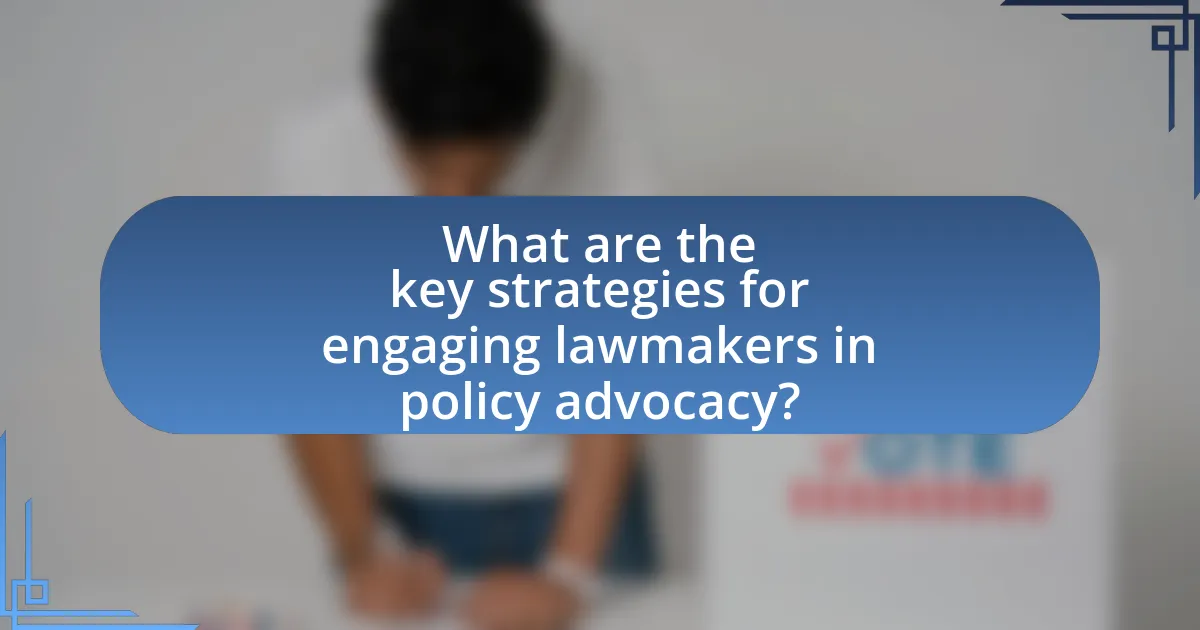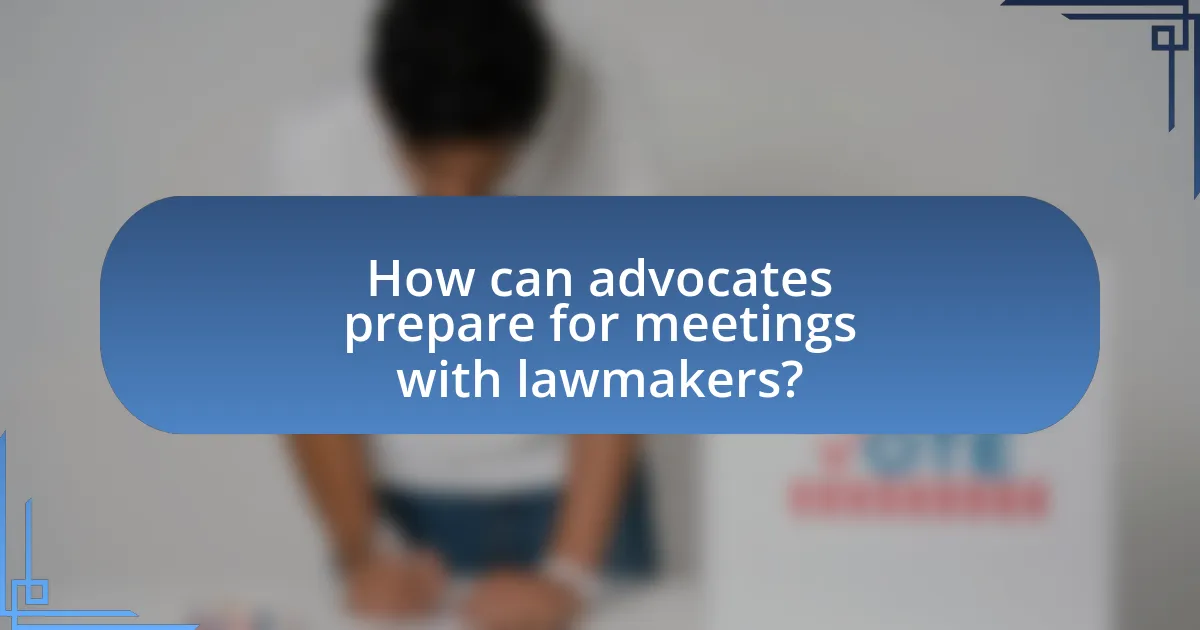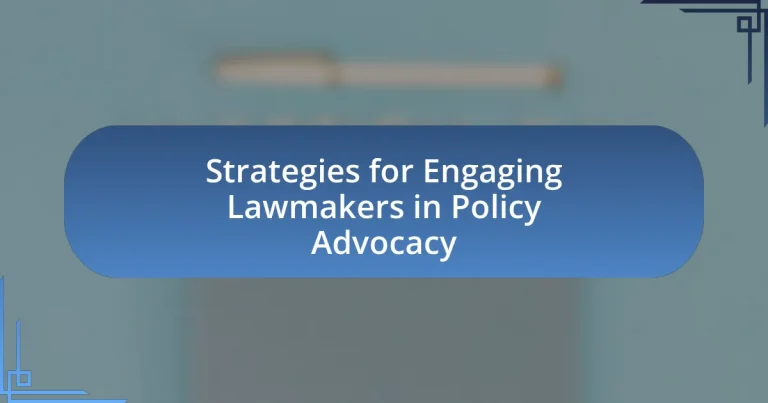The article focuses on strategies for engaging lawmakers in policy advocacy, emphasizing the importance of building relationships, effective communication, and grassroots mobilization. Key strategies include establishing personal connections with lawmakers, presenting clear and concise information, and tailoring messages for different audiences. The article also highlights the significance of understanding lawmakers’ priorities, preparing for meetings, and utilizing data-driven arguments to enhance advocacy efforts. Additionally, it discusses the role of coalition-building and grassroots campaigns in influencing legislative decisions, as well as best practices for successful advocacy and common pitfalls to avoid.

What are the key strategies for engaging lawmakers in policy advocacy?
Key strategies for engaging lawmakers in policy advocacy include building relationships, providing clear and concise information, and mobilizing grassroots support. Establishing personal connections with lawmakers fosters trust and opens lines of communication, which is essential for effective advocacy. Presenting well-researched, straightforward data helps lawmakers understand the implications of policies, making it easier for them to support initiatives. Additionally, mobilizing grassroots support demonstrates public interest and can influence lawmakers’ decisions, as seen in various successful advocacy campaigns where community engagement led to legislative changes.
How can effective communication enhance advocacy efforts?
Effective communication enhances advocacy efforts by clearly conveying messages that resonate with target audiences, including lawmakers. When advocates articulate their positions with clarity and precision, they increase the likelihood of influencing policy decisions. Research indicates that effective communication strategies, such as storytelling and data-driven arguments, can significantly improve engagement levels; for instance, a study by the FrameWorks Institute found that narratives can shift public perceptions and policy priorities. By utilizing effective communication, advocates can build trust, foster relationships, and mobilize support, ultimately leading to more successful advocacy outcomes.
What communication techniques resonate most with lawmakers?
Effective communication techniques that resonate most with lawmakers include clear messaging, data-driven arguments, and personal storytelling. Clear messaging ensures that lawmakers quickly grasp the core issue, while data-driven arguments provide the evidence needed to support policy changes, as studies show that lawmakers respond positively to statistics and factual information. Personal storytelling adds an emotional appeal, making the issue relatable and compelling, which is crucial in influencing legislative decisions. Research indicates that lawmakers are more likely to engage with constituents who present their cases in a straightforward, evidence-based manner combined with personal narratives that highlight real-world impacts.
How can advocates tailor their messages for different audiences?
Advocates can tailor their messages for different audiences by understanding the specific interests, values, and concerns of each group. This involves conducting audience analysis to identify what resonates with them, such as using relevant data, anecdotes, or language that aligns with their beliefs. For instance, when addressing lawmakers, advocates might emphasize economic benefits or public health impacts, while community members may respond better to personal stories or local statistics. Research shows that targeted messaging increases engagement; a study by the FrameWorks Institute found that messages framed in ways that connect with audience values lead to greater support for policy initiatives.
Why is relationship-building important in policy advocacy?
Relationship-building is crucial in policy advocacy because it fosters trust and collaboration between advocates and lawmakers. Strong relationships enable advocates to effectively communicate their policy goals, ensuring that lawmakers understand the issues at stake and the potential impact on their constituents. Research indicates that legislators are more likely to support initiatives when they have established connections with advocates, as these relationships facilitate open dialogue and mutual understanding. For instance, a study by the National Conference of State Legislatures found that personal relationships significantly influence legislative decision-making, highlighting the importance of trust in advocacy efforts.
What methods can be used to build rapport with lawmakers?
To build rapport with lawmakers, effective methods include establishing personal connections, demonstrating knowledge of their priorities, and maintaining consistent communication. Personal connections can be fostered through informal meetings, attending community events, or engaging in shared interests, which helps lawmakers see advocates as relatable individuals rather than just representatives of organizations. Demonstrating knowledge of lawmakers’ priorities involves researching their legislative agendas and aligning advocacy efforts with their goals, which shows respect for their work and enhances credibility. Consistent communication, through regular updates and follow-ups, keeps advocates on lawmakers’ radar and reinforces relationships over time. These methods are supported by studies indicating that personal relationships and informed advocacy significantly increase the likelihood of successful policy influence.
How can advocates maintain long-term relationships with policymakers?
Advocates can maintain long-term relationships with policymakers by consistently engaging in open communication and demonstrating mutual respect. Regularly providing policymakers with relevant information, updates on issues, and feedback on their initiatives fosters trust and collaboration. Additionally, advocates should participate in policymaking processes, attend public meetings, and offer support for initiatives that align with their goals, which reinforces their commitment to shared objectives. Research indicates that sustained engagement leads to more effective advocacy outcomes, as evidenced by studies showing that organizations with ongoing relationships with lawmakers are more successful in influencing policy decisions.
What role does grassroots mobilization play in engaging lawmakers?
Grassroots mobilization plays a crucial role in engaging lawmakers by amplifying the voices of constituents and demonstrating public support for specific issues. This engagement is evidenced by the ability of organized grassroots efforts to mobilize large numbers of individuals to contact their representatives, attend town hall meetings, and participate in advocacy campaigns. For instance, studies have shown that when constituents express their views through letters, calls, or social media, lawmakers are more likely to take notice and respond, as these actions signal a strong voter interest in particular policies. Additionally, grassroots movements can effectively shape the political agenda by raising awareness and influencing public opinion, which lawmakers consider when making decisions.
How can grassroots campaigns effectively influence legislative decisions?
Grassroots campaigns can effectively influence legislative decisions by mobilizing community members to advocate for specific policy changes. These campaigns leverage local networks to create a strong, unified voice that lawmakers cannot ignore. For instance, when constituents contact their representatives, share personal stories, and organize public demonstrations, they demonstrate widespread support for particular issues. Research indicates that lawmakers are more likely to respond to constituents’ concerns when they perceive significant public interest, as evidenced by a study from the National Bureau of Economic Research, which found that grassroots lobbying can significantly sway legislative outcomes. Additionally, grassroots campaigns often utilize social media to amplify their message, reaching a broader audience and increasing pressure on legislators to act in accordance with public sentiment.
What tools are available for organizing grassroots efforts?
Tools available for organizing grassroots efforts include social media platforms, email marketing services, and community organizing software. Social media platforms like Facebook and Twitter facilitate outreach and mobilization by allowing users to share information quickly and engage with a wider audience. Email marketing services, such as Mailchimp, enable organizations to communicate directly with supporters, providing updates and calls to action. Community organizing software, like Mobilize or NationBuilder, helps manage events, track volunteer engagement, and streamline communication among team members. These tools have been proven effective in various campaigns, such as the 2018 midterm elections in the United States, where grassroots organizations utilized these platforms to increase voter turnout and engagement.

How can advocates prepare for meetings with lawmakers?
Advocates can prepare for meetings with lawmakers by conducting thorough research on the lawmaker’s positions, interests, and recent legislative activities. This preparation allows advocates to tailor their messages effectively, ensuring alignment with the lawmaker’s priorities. For instance, understanding a lawmaker’s voting history on specific issues can help advocates present compelling arguments that resonate with their values. Additionally, preparing concise talking points and relevant data strengthens the advocate’s position, making it easier to communicate key messages clearly and persuasively. Engaging in role-playing scenarios can also enhance confidence and readiness for potential questions or objections during the meeting.
What research should advocates conduct before meeting lawmakers?
Advocates should conduct research on lawmakers’ voting records, policy positions, and constituent interests before meeting them. Understanding a lawmaker’s past decisions and current stances on relevant issues allows advocates to tailor their messages effectively. For instance, a study by the Pew Research Center indicates that 70% of lawmakers prioritize constituent feedback when making decisions, highlighting the importance of aligning advocacy efforts with the interests of the lawmaker’s constituents. Additionally, researching recent legislation and committee memberships can provide insights into a lawmaker’s priorities and areas of influence, enabling advocates to present compelling arguments that resonate with the lawmaker’s agenda.
How can understanding a lawmaker’s priorities shape advocacy strategies?
Understanding a lawmaker’s priorities allows advocates to tailor their strategies effectively, ensuring that their messages resonate with the legislator’s interests and goals. By aligning advocacy efforts with the specific issues that lawmakers prioritize, advocates can increase the likelihood of gaining support for their initiatives. For instance, if a lawmaker is focused on healthcare reform, advocacy strategies can emphasize how proposed policies will improve health outcomes, thereby appealing directly to the lawmaker’s agenda. This targeted approach is supported by research indicating that legislators are more responsive to constituents who present solutions that align with their established priorities, enhancing the chances of successful policy outcomes.
What are the best practices for preparing advocacy materials?
The best practices for preparing advocacy materials include clearly defining the target audience, crafting a compelling message, and utilizing data to support claims. Identifying the audience ensures that the materials resonate with their interests and concerns, while a strong message captures attention and motivates action. Incorporating relevant statistics or case studies enhances credibility; for instance, a study by the Pew Research Center found that data-driven arguments are more persuasive to policymakers. Additionally, using clear visuals and concise language improves comprehension and retention, making the materials more effective in conveying the intended message.
How can advocates effectively present their case during meetings?
Advocates can effectively present their case during meetings by clearly articulating their key messages, using data and personal stories to support their arguments, and engaging in active listening. Clear articulation ensures that the main points are communicated succinctly, which is crucial in a limited time frame. Utilizing data, such as statistics from reputable sources, strengthens the argument by providing factual evidence that lawmakers can reference. Personal stories create emotional connections, making the issue more relatable and compelling. Active listening allows advocates to respond to lawmakers’ concerns and questions, fostering a two-way dialogue that can lead to more productive discussions. Research indicates that effective communication strategies significantly enhance advocacy efforts, as demonstrated in studies by the American Psychological Association, which highlight the importance of clarity and emotional engagement in persuasive communication.
What techniques can be used to engage lawmakers during discussions?
To engage lawmakers during discussions, techniques such as building personal relationships, utilizing data-driven arguments, and employing storytelling can be effective. Building personal relationships fosters trust and opens lines of communication, making lawmakers more receptive to advocacy efforts. Data-driven arguments provide concrete evidence that supports policy positions, enhancing credibility and persuading lawmakers with factual information. Storytelling humanizes issues, making them relatable and memorable, which can influence lawmakers’ perspectives and decisions. These techniques are supported by research indicating that personal connections and compelling narratives significantly impact legislative outcomes.
How can advocates handle objections or pushback from lawmakers?
Advocates can handle objections or pushback from lawmakers by employing active listening, presenting data-driven arguments, and building relationships. Active listening allows advocates to understand the concerns of lawmakers, which can lead to more effective responses. Presenting data-driven arguments, such as statistics or case studies, can substantiate the advocate’s position and address specific objections. Building relationships through consistent communication and engagement fosters trust, making lawmakers more receptive to the advocate’s perspective. For instance, a study by the American Political Science Association highlights that personal connections between advocates and lawmakers significantly enhance the likelihood of policy support.

What are the common pitfalls to avoid in policy advocacy?
Common pitfalls to avoid in policy advocacy include lack of clear objectives, insufficient stakeholder engagement, and failure to communicate effectively. Clear objectives are essential; without them, advocacy efforts can become unfocused and ineffective. Insufficient stakeholder engagement can lead to missed opportunities for coalition-building and support, as evidenced by studies showing that inclusive advocacy efforts yield better policy outcomes. Additionally, failure to communicate effectively can result in misunderstandings and reduced impact; research indicates that clear messaging significantly enhances the likelihood of policy adoption.
What mistakes do advocates often make when engaging lawmakers?
Advocates often make the mistake of failing to understand the priorities and pressures faced by lawmakers. This lack of awareness can lead to ineffective communication and missed opportunities for collaboration. For instance, advocates may focus solely on their specific issues without considering how those issues align with the broader legislative agenda, which can alienate lawmakers who are juggling multiple competing interests. Additionally, advocates sometimes underestimate the importance of building relationships over time, opting instead for one-off meetings that do not foster trust or rapport. Research indicates that sustained engagement and relationship-building are crucial for successful advocacy, as lawmakers are more likely to respond positively to advocates they know and trust.
How can advocates ensure they are not perceived as self-serving?
Advocates can ensure they are not perceived as self-serving by prioritizing the interests of the community they represent over personal gain. This can be achieved through transparent communication, actively listening to constituents, and demonstrating a commitment to the public good. For instance, research shows that advocates who engage in collaborative efforts with community members and stakeholders build trust and credibility, which mitigates perceptions of self-interest. By focusing on shared goals and outcomes that benefit the broader population, advocates can effectively position themselves as genuine representatives of their constituents rather than as self-serving individuals.
What strategies can help avoid miscommunication with lawmakers?
To avoid miscommunication with lawmakers, clear and concise communication is essential. Utilizing straightforward language, avoiding jargon, and being specific about requests can significantly enhance understanding. Research indicates that lawmakers often have limited time to process information, so presenting key points upfront and using bullet points or summaries can facilitate quicker comprehension. Additionally, establishing a consistent communication channel, such as regular updates or meetings, fosters a relationship that encourages open dialogue and reduces the likelihood of misunderstandings.
How can advocates learn from past advocacy efforts?
Advocates can learn from past advocacy efforts by analyzing the outcomes and strategies used in previous campaigns. This analysis allows advocates to identify successful tactics, such as coalition-building and effective messaging, as well as pitfalls to avoid, like insufficient stakeholder engagement. For instance, the 2010 Affordable Care Act campaign demonstrated the importance of grassroots mobilization and data-driven approaches, which led to significant public support. By studying these historical examples, advocates can refine their strategies and enhance their effectiveness in engaging lawmakers in future policy advocacy.
What metrics should be used to evaluate the success of advocacy strategies?
To evaluate the success of advocacy strategies, key metrics include policy changes, stakeholder engagement levels, and media coverage. Policy changes indicate the effectiveness of advocacy efforts in influencing legislation or regulations. Stakeholder engagement levels, measured through participation rates in events or communications, reflect the mobilization of supporters and allies. Media coverage, assessed by the volume and sentiment of press mentions, demonstrates public awareness and perception of the advocacy issue. These metrics provide concrete evidence of advocacy impact and effectiveness in achieving desired outcomes.
How can feedback from lawmakers improve future advocacy efforts?
Feedback from lawmakers can significantly enhance future advocacy efforts by providing insights into legislative priorities and concerns. When advocates receive specific feedback from lawmakers, they can tailor their strategies to align with the interests and needs of those lawmakers, increasing the likelihood of support for their initiatives. For instance, lawmakers may highlight areas where they require more data or clarification, allowing advocates to refine their messaging and focus on compelling evidence that resonates with legislative goals. This iterative process fosters a more collaborative relationship, ultimately leading to more effective advocacy outcomes.
What are the best practices for successful policy advocacy?
The best practices for successful policy advocacy include building strong relationships with lawmakers, clearly defining policy goals, and utilizing data-driven arguments. Establishing trust and open communication with legislators fosters collaboration and increases the likelihood of policy adoption. Clearly defined goals ensure that advocacy efforts are focused and measurable, which is essential for tracking progress and demonstrating impact. Utilizing data-driven arguments, such as statistics and case studies, strengthens the case for policy change by providing concrete evidence of the issue’s significance and potential solutions. These practices are supported by research indicating that effective advocacy often leads to successful policy outcomes, as seen in various case studies where organized efforts resulted in legislative changes.
How can advocates create a compelling narrative for their cause?
Advocates can create a compelling narrative for their cause by clearly articulating the problem, presenting relatable stories, and demonstrating the impact of their advocacy. A well-defined problem establishes urgency, while personal stories humanize the issue, making it more relatable to lawmakers and the public. For instance, research by the FrameWorks Institute shows that narratives that include personal experiences can significantly increase public support for policy changes. Additionally, using data and statistics to illustrate the problem’s scope and potential solutions reinforces the narrative’s credibility, making it more persuasive.
What role does coalition-building play in enhancing advocacy efforts?
Coalition-building plays a critical role in enhancing advocacy efforts by uniting diverse stakeholders to amplify their collective voice and influence. When organizations collaborate, they can pool resources, share expertise, and create a more compelling narrative that resonates with lawmakers. For instance, coalitions can demonstrate broad public support for a policy issue, which can sway decision-makers. Research shows that advocacy campaigns involving coalitions are often more successful; a study by the Center for American Progress found that coordinated efforts can increase the likelihood of policy change by up to 50%. This evidence underscores the effectiveness of coalition-building in achieving advocacy goals.


